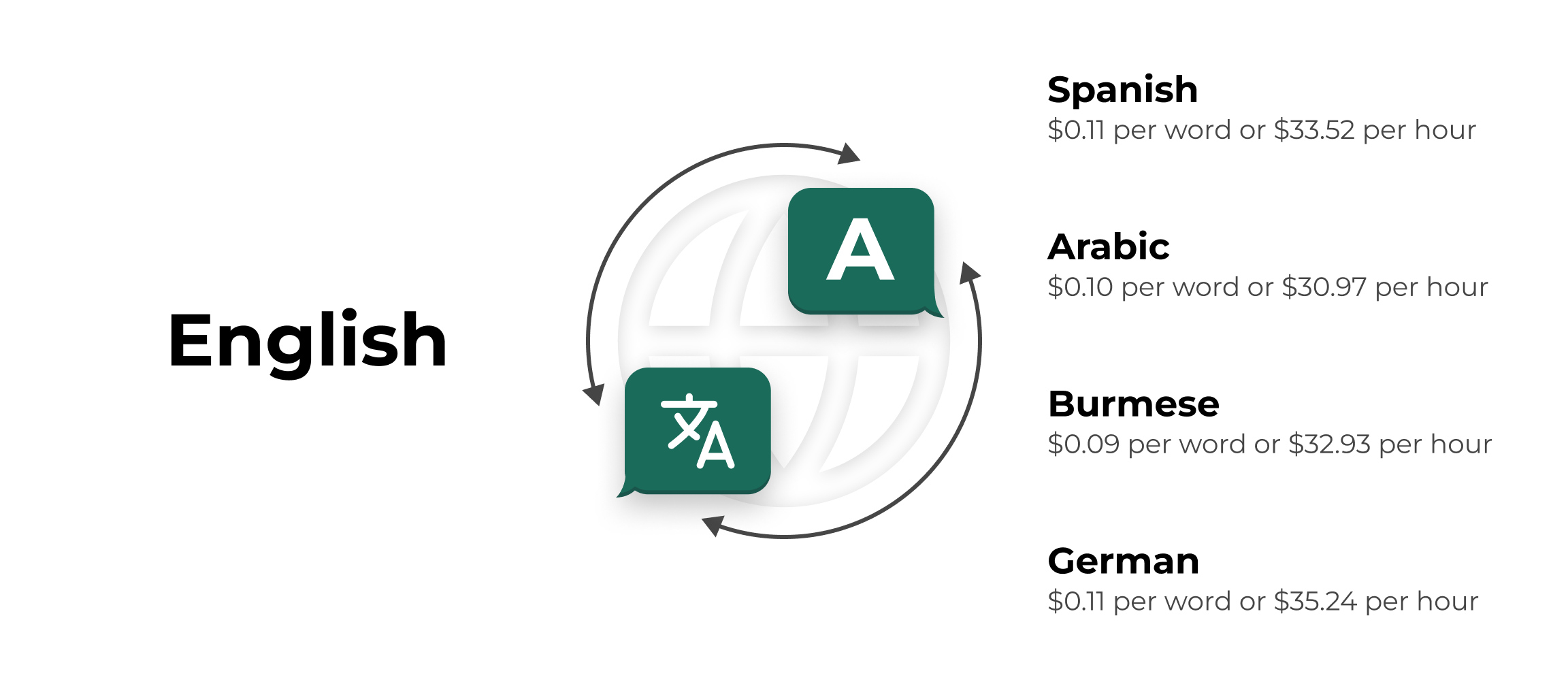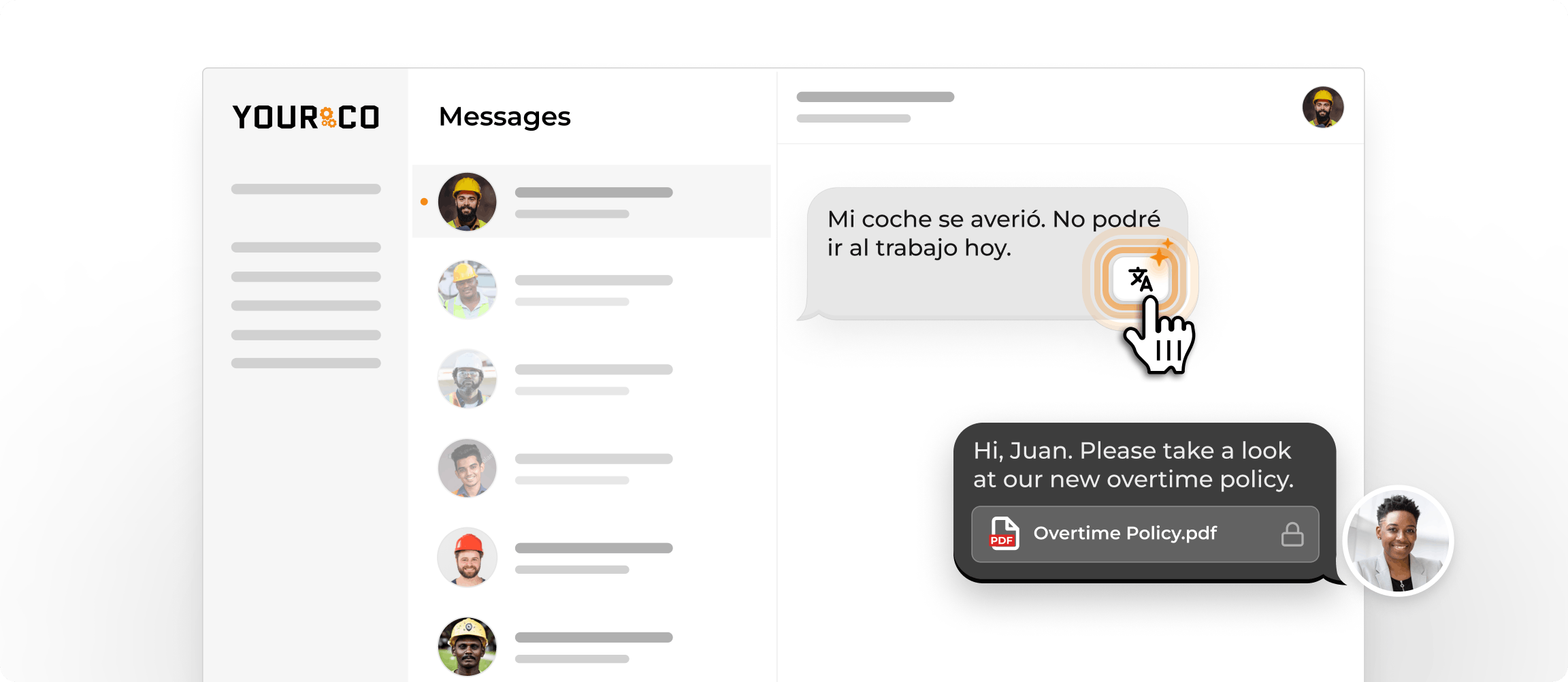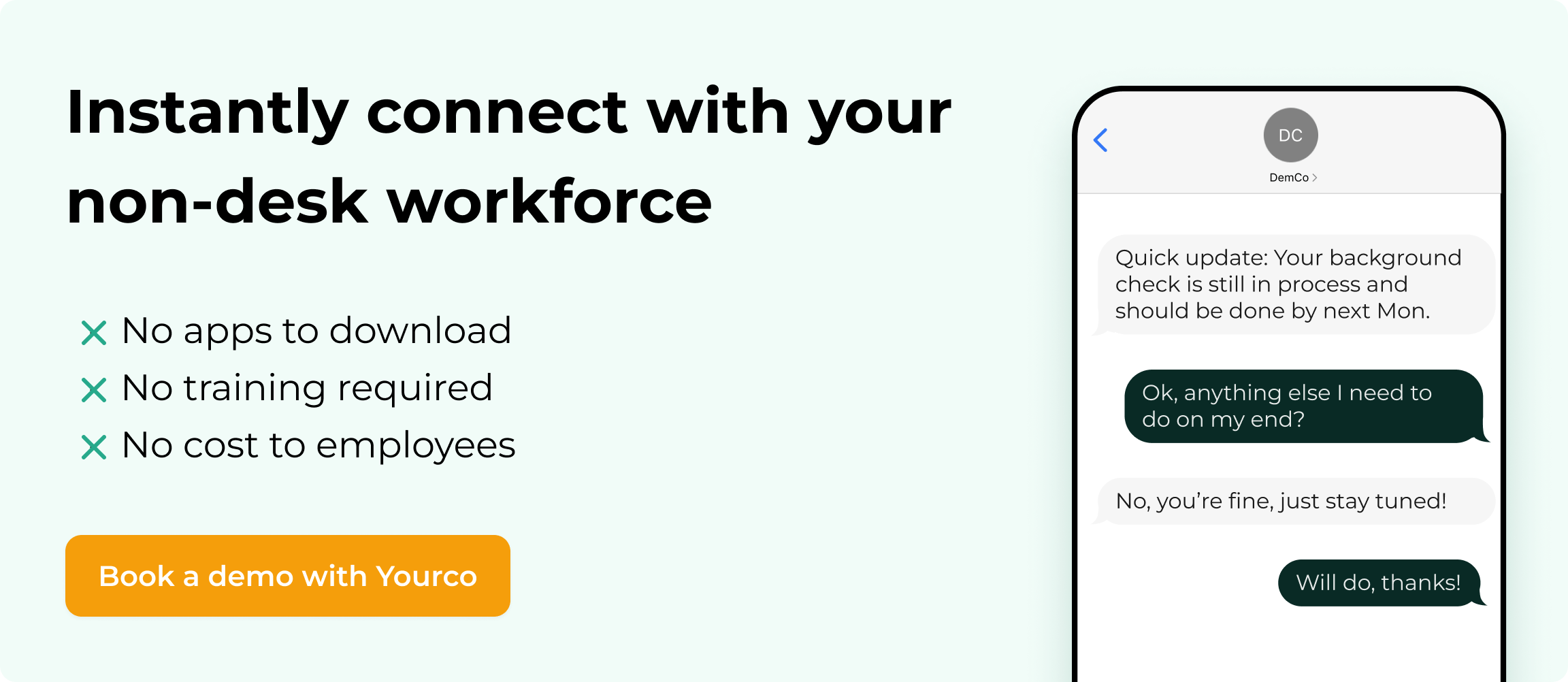What Is the Typical Cost of Professional Translation Services?


The cost of professional translation services varies based on document type, urgency, and translator expertise. Most providers charge by the word or page, with extra fees for rush jobs or specialized content.
For businesses with multilingual teams, translation is key to clear communication and compliance. This article outlines average translation rates, common pricing models, and tools that make multilingual communication easier and more affordable.
The Importance of Professional Translation Services
Workplaces are more diverse than ever. Research shows that companies with racial and ethnic diversity are 35% more likely to outperform their industry peers financially. However, this diversity brings communication challenges that can impact business operations.
Language barriers can affect everything from team collaboration to employee satisfaction, reducing productivity and creating obstacles to effective teamwork. Professional translation services offer more than just word-for-word conversion. They provide culturally sensitive communication that maintains the intended meaning across languages.
When implemented effectively, professional translation services create an inclusive environment where every employee can fully participate, regardless of their primary language. This leads to better collaboration, increased engagement, and more efficient operations across multilingual teams.
What Is a Good Translation Rate per Word?
In general, a good translation rate is between $0.10-$0.20 per written word or $24.32-$56.31 per hour. To give you an idea of more specific costs, here are a few average translation prices for English to other languages:
- English to Spanish translation services rates – $0.11 per word or $33.52 per hour
- English to Arabic translation services rates – $0.10 per word or $30.97 per hour
- English to Burmese translation services rates – $0.10 per word or $32.93 per hour
- English to German translation services rates – $0.11 per word or $35.24 per hour
If you're hoping for a more convenient option for translating text messages with employees, consider using Yourco. With Yourco, you can translate into 135 different languages and dialects, such as English to Spanish, Spanish to German, Arabic to Chinese, and more. Not only does Yourco translate each word, but it also detects colloquial phrases, making it a valuable tool for ensuring clear communication with your employees.
How Translation Services Charge: 5 Common Pricing Models
Understanding how translation services charge helps you control costs. Translation providers use different pricing structures that directly impact your project expenses. Your content type, volume, and timeline requirements should determine your choice of model. Some models work better for predictable projects, while others excel when scope or complexity varies. Knowledge of these five approaches helps you select the most cost-effective option and avoid billing surprises.
Per-Word Pricing
Per-word pricing dominates the industry because both clients and translators find it straightforward. This model applies a specific rate for each translated word.
The benefits appear clear: transparent pricing lets you calculate costs easily, scalable rates work for any project size, and predictable expenses help with budget planning. This model works best for large documents where content volume drives the primary cost. A 10,000-word employee handbook at $0.15 per word costs exactly $1,500, eliminating guesswork.
Always ask whether pricing uses source or target word count, since this distinction can change your final costs by 10-20% depending on how languages expand during translation.
Per-Hour Pricing
Hourly rates charge you based on translator time rather than word count. This approach offers exceptional flexibility for complex projects, allows translators to focus on quality without rushing, and adapts well when you need multiple revisions or ongoing collaboration.
This model excels for specialized tasks requiring extensive research, subject matter expertise, or complex formatting. Translating benefits information for your multinational workforce often requires time to research local regulations, verify terminology, and ensure compliance across jurisdictions. Compliance documentation demands careful attention to legal nuances that translators cannot rush.
Expect less predictable total costs compared to per-word pricing. The hourly model works best when you prioritize quality and accuracy over cost certainty, particularly for high-stakes documents where errors carry serious consequences.
Per-Character / Per-Million Characters
Asian languages like Japanese, Chinese, or Korean require character-based pricing because traditional word counting proves less relevant. This model charges based on character count rather than words, providing more appropriate pricing for languages without clear word boundaries.
The advantages include language appropriateness for different writing systems, consistency across various language families, and fairness when translating between vastly different language structures. Western clients often find this model initially confusing compared to familiar word-based pricing.
Multinational organizations with Asian operations gain significant value from this model. Companies translating safety protocols for manufacturing facilities in China or employee communications for offices in Japan need character-based pricing that reflects actual translation effort. This model also serves technical documentation well where precision in character count matters for formatting and display purposes.
Flat Project Fees & Minimum Charges
Flat project fees involve a fixed price regardless of word count or time spent, offering maximum budget certainty from the start. You know the total cost of translation services upfront with no surprises, accounting becomes simplified with one payment, and pricing focuses on deliverable value rather than input metrics.
Most translation providers set minimum charges for small projects to cover administrative overhead, setup time, and project management costs. These minimums typically range from $50 to $200, making very small translations proportionally expensive but ensuring quality service.
This model excels for comprehensive projects with clearly defined parameters. Translating a complete employee onboarding package (handbook, policies, benefits guides, and training materials) eliminates uncertainty about scope changes and provides predictable budgeting for your HR department. Organizations can maximize this model when they clearly define deliverables and scope boundaries upfront.
Hybrid / Subscription Models
Organizations with regular, ongoing translation needs often find subscription-based translation services appealing with their monthly word allowances or service credits. These models often leverage technology to provide cost savings.
Organizations with consistent translation requirements across multiple departments benefit from subscription models. If your company regularly translates safety updates, policy changes, or recurring communications, these models can provide substantial savings compared to project-by-project pricing. Some providers offer tiered subscriptions based on monthly volume, with unused credits rolling over or charging additional usage at predetermined rates.
Companies with predictable translation volumes, such as regular employee communications, training updates, or compliance documentation, find this approach particularly suitable. The subscription model also converts variable translation costs into predictable monthly expenses, making budget planning easier.
How These 7 Factors Determine Your Translation Costs
Seven interconnected factors determine the cost of translation services and can significantly impact your final expenses. Understanding these elements helps you predict costs and spot savings opportunities.
Document Length & Content Volume
Document length directly impacts costs in most pricing models, but larger projects often qualify for volume discounts. Translation providers typically offer tiered pricing where rates decrease as word count increases. Companies can achieve significant cost savings through batch translation requests by combining employee handbook updates, safety manuals, and training materials into a single project.
You can distinguish necessary translations from optional materials by conducting a content audit. You might discover that some internal documents don't require professional translation, allowing you to focus your budget on mission-critical communications that keep your workforce safe and informed.
Common workplace documents that require translation include:
- Employee handbooks and policy manuals
- Safety protocols and emergency procedures
- Training materials and standard operating procedures
- Benefits enrollment guides and open enrollment communications
- Shift schedules and time-off policies
- Incident reporting forms and compliance documentation
- New hire onboarding materials and orientation packets
Language Pair
Translator availability makes language combinations significantly affect pricing. Common language pairs cost $0.10-$0.20 per word, while rare language pairs can cost $0.25 or more per word. Larger translator pools for widely spoken languages keep prices competitive.
Companies should prioritize languages based on employee demographics, focusing budgets on the most commonly spoken languages among staff first. This approach ensures maximum impact while controlling costs, rather than trying to translate everything into every possible language at once.
Quality Level
Different quality tiers serve different purposes and budgets. Machine translation with human editing offers the most economical option, typically costing 40-60% less than traditional human translation. Standard human translation works for most business communications, while premium translation with editing suits customer-facing materials. Certified translation commands the highest rates but legal documents or regulatory compliance often require it.
Match your quality level to content purpose. Use premium translation for safety-critical instructions where accuracy could prevent injuries, but consider machine translation with light editing for internal announcements or routine updates.
File Format & Layout Complexity
Complex formatting, tables, graphics, or specific layout requirements often incur additional desktop publishing (DTP) charges beyond basic translation fees. Documents that require pre-processing, such as OCR for scanned safety posters or text extraction from complex PDF benefit guides, may carry extra fees that can surprise managers who focus only on per-word rates.
Provide clean, editable source files whenever possible to minimize additional charges. If you regularly translate formatted materials like employee newsletters or safety signage, discuss bulk formatting rates with your translation provider to reduce per-project costs.
Turnaround Time & Urgency
Rush orders command premium pricing that can inflate your budget. 24-hour turnaround may cost 25-50% more, while same-day service could add 75-100% to your bill. These premiums result from the resource reallocation and prioritization your provider implements to meet urgent deadlines.
Consider the difference between emergency safety communications that genuinely need immediate translation versus routine policy updates that can follow normal timelines. Build translation time into your project schedules whenever possible. Planning ahead represents one of the most effective ways to control translation costs without compromising quality.
Certification & Compliance Needs
Legal, medical, and regulated industries often require certified translations that command higher rates due to liability concerns and specialized knowledge requirements. Certified translators must understand both source and target legal or regulatory systems, which limits the pool of qualified professionals and drives up pricing.
Identify which documents truly require certification, such as employment contracts for international workers or safety compliance documentation for regulatory submissions, versus those that need accurate but non-certified translation. This distinction can save substantial costs while ensuring you meet actual legal requirements rather than perceived ones.
Translator Expertise & Location
Technical, legal, or medical fields typically demand higher prices because translators need subject matter expertise beyond language skills. Location also influences pricing, with rates varying significantly by region. North American and Western European translators generally charge more than their counterparts in emerging markets.
When you translate technical training materials or industry-specific safety protocols, investing in specialized expertise often proves more cost-effective than hiring general translators who may require extensive revision cycles. Build relationships with translators familiar with your industry to improve both efficiency and accuracy over time while potentially securing preferential rates.
Types of Professional Translation Services
When it comes to workplace communications, several types of professional translation services are available, each suited for different business needs and contexts.
Human Translation Services
Professional human translators provide the highest level of accuracy and cultural sensitivity for critical business communications. These services are essential for translating complex materials like legal documents, safety guidelines, and HR policies where precision is paramount. They offer the ability to maintain the tone, nuances, and exact meanings that may be lost with automated systems.
Automated Translation Tools
AI-powered translation tools offer quick, scalable solutions for day-to-day communications. While these tools may not capture all cultural nuances, they're increasingly sophisticated and can handle routine communications effectively. They're particularly useful for real-time communication needs and high-volume content.
For everyday workplace interactions, AI translations can significantly enhance efficiency. Yourco's AI-powered platform enables seamless, multilingual communication within teams. Whether it's translating internal messages, scheduling updates, or other routine communications, AI translations ensure that messages are understood by employees from diverse linguistic backgrounds without the delays or costs associated with human translators. This tool is particularly valuable for teams spread across different regions, helping them stay aligned and productive. Additionally, AI translations can adapt to new contexts as they learn from ongoing usage, providing increasingly accurate and relevant translations for day-to-day conversations.
Specialized Translation Services
As mentioned earlier, some communications require specialized expertise beyond standard translation. These services may involve subject matter experts to ensure accuracy in complex fields, often commanding higher rates. Specialized translation is ideal for technical documents, legal contracts, or industry-specific terminology where in-depth knowledge is critical for accuracy.
Costly Translation Mistakes You Can Easily Avoid
Smart managers know that translation procurement involves more than comparing price quotes. Here are the traps that derail budgets and compromise quality, plus practical solutions to sidestep them entirely.
Don't chase the lowest per-word rate. The cheapest vendor often delivers the most expensive results. Poor translations require costly revisions, create project delays, and damage your credibility with employees. Instead, evaluate translators based on their proven track record with companies like yours, their expertise in your industry, and their ability to deliver consistent results across multiple projects.
Context matters more than you think. Translating safety protocols or benefits documentation requires deep understanding of regulatory requirements, not just language skills. Supply translators with comprehensive background materials including glossaries, style guides, and detailed context about your operations. This investment upfront prevents costly misunderstandings later.
How to Choose the Right Translation Service
Choosing the best translation service for your workplace requires careful evaluation of your specific needs and the key factors that can impact communication and productivity.
Understand Your Translation Needs
Before selecting a service, assess the nature of your communication requirements:
- Content: Is the content simple (e.g., announcements) or complex (e.g., legal documents or technical manuals)?
- Volume: How frequently will you require translations, and how extensive is the content?
- Speed: Do you need translations delivered in real-time or within specific deadlines?
Understanding these elements will help you pinpoint whether your needs are better suited to human translators, AI-powered tools, or a hybrid approach.
Consider Key Factors Before Choosing a Service
Once you've clarified your needs, evaluate translation services based on these critical factors:
- Accuracy and Cultural Sensitivity: Ensure the service handles industry-specific terminology and adapts messaging to cultural nuances, especially for sensitive content like HR policies or regulatory documents.
- Language Coverage: Select a service that supports the languages and dialects of your workforce, ensuring clarity across all teams.
- Integration with Existing Tools: Choose a solution that works seamlessly with your HR software, communication platforms, or document management systems.
- Cost and ROI: Consider upfront and ongoing costs, weighing them against the productivity and compliance benefits the service provides.
- Flexibility and Scalability: Look for a service that can adapt to your changing business needs, whether it's increased translation volume or new language requirements.
By taking these steps, you can select a translation service that aligns with your organizational goals and fosters an inclusive workplace culture.
Break Free from Translation Costs with Yourco
Professional translation services can have a real impact on business operations. Accurate translation of safety guidelines, regulatory documents, and daily communications helps prevent mistakes and compliance issues. In today’s diverse workplaces, it’s essential to connect with employees in their preferred language. Yourco makes that possible through its two-way communication platform with built-in translation.
Translating simple day-to-day phrases like shift changes, safety reminders, or policy updates can quickly become expensive with traditional services. With Yourco, these messages are automatically translated at no extra cost. Critical updates reach your multilingual workforce instantly, without rush fees or project minimums.
Key benefits of Yourco’s AI-powered translation:
- Translates automatically across 135+ languages and dialects without per-word costs
- Reduces errors caused by slang, acronyms, or shift-related terminology
- Provides instant delivery and translation for real-time communication
- Eliminates vendor contracts, rush fees, and project minimums
- Learns your organization’s terminology for more accurate translations over time
This approach turns multilingual communication into a built-in capability, not an added expense. Whether you are sending shift reminders to warehouse staff in Spanish, safety alerts to teams in Mandarin, or policy updates to drivers in Arabic, Yourco ensures everyone receives information in a language they understand.
Ready to eliminate translation costs from your communication budget? Try Yourco for free today or schedule a demo and see the difference the right workplace communication solution can make in your company.
Frequently Asked Questions
Are AI translation tools accurate enough for workplace communication?
Yes. Modern AI translation tools like the one built into Yourco use context-aware algorithms that recognize slang, idioms, and industry-specific terms. While human translators are still best for legal or highly technical documents, AI tools work well for everyday communication such as shift updates, safety reminders, and HR messages.
How can businesses reduce translation costs without sacrificing quality?
Companies can lower costs by using AI-powered platforms for routine communication while reserving professional translators for complex or regulated materials. Centralizing translation through a tool like Yourco removes per-word vendor fees and ensures all departments share consistent and accurate translations.
What types of workplace documents should always be professionally translated?
Documents that affect safety, compliance, or employee rights should always be translated by professionals or verified experts. This includes employee handbooks, safety procedures, benefits guides, and legal notices. Everyday communication such as shift schedules or reminders can be handled through automated translation tools.
Why should organizations integrate translation directly into their communication platforms?
Integrating translation into communication systems like Yourco’s two-way messaging platform eliminates delays, reduces human error, and ensures every employee receives information in real time. It also helps companies maintain inclusivity and compliance without needing external vendors or added project management.






